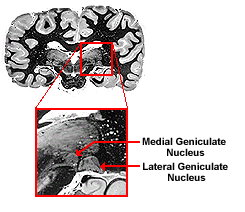| Ferreting Out the Facts About Visual System Wiring |
| Ferreting Out the Facts About Visual System Wiring |
| By Ellen Kuwana Neuroscience for Kids Staff Writer June 23, 2000
|
 Ferret Brain (top view)
|
The researchers chose to look at ferret brains because ferrets are
born relatively immature. Even though ferret brains are less developed
than human brains at birth, they still follow the same developmental
pattern or "wiring guide." Nerve cells in ferrets, just like those in
humans, grow along pathways from the sense organs (eyes or nose, for
example), through parts of the brain such as the thalamus, then on to the
cortex, where the signals are processed. When humans are born, much of the
wiring is already established, but in the ferret newborn, the nerves grow
into the thalamus after birth. Scientists "rewired" the ferrets' brains by destroying the pathway that brings auditory information to the thalamus. The researchers found that if they prevented the auditory (hearing) nerve from growing into the thalamus, that the optic (eye) nerve would make a double connection and wire itself to both the auditory (hearing) and the visual (seeing) areas in the cortex. How did the scientists know that the brain had rewired itself? In the visual area, normally the nerves are arranged in a pattern that resembles a pinwheel; the auditory region's normal organization is more in lines. In the rewired ferrets, the auditory region was patterned in pinwheels. So the scientists knew that the pathways the nerves took were different -- but were they functioning differently, too? |
| The rewired ferrets had eyes that were hooked up to the part of
the brain normally involved in hearing. So did that rewired area "see" or
"hear"? The scientists taught the rewired ferrets to turn their heads
right if they saw a light and left if they heard a sound. The ferrets'
brains were only rewired on one side, so the normal side of the brain
served as a control in the experiment. What the researchers found was that
the ferrets were seeing lights with their rewired auditory cortex! So not
only was the wiring different, the "hearing" cortex was working to process
input from the eye. This rewired pathway did not work as well as the
normal visual pathway -- it was not as sensitive -- but it was functional.
The animals were "seeing" with their auditory cortex. Neuroscientists had previously thought that these specialized sensory areas were designated by birth to perform certain tasks. This work shows that these parts of the brain can adapt and change. Cells organize during development (before birth) to form these specialized structures, but input from the environment (after birth) is necessary to stabilize these areas. Before they are stabilized, different input can affect their function. This may shed light on how younger brains are better able to recover from injuries, whereas more mature brains are less capable of repair or rewiring to compensate for damaged areas. For example, some young children with severe epilepsy undergo surgery to remove half of their brain to control the spread of the seizure. Many of these children recover to develop normally if the surgery is done at an early age. Better understanding of how the brain compensates for damage (whether it be from disease or injury) will help medical researchers searching for treatments for various brain diseases. |

Auditory (medial geniculate nucleus) and visual (lateral geniculate nucleus) areas of the thalamus in humans. Images courtesy of the Knowledge Weavers Project. |
|
References:
|
| BACK TO: | Neuroscience In The News | Table of Contents |
![[email]](./gif/menue.gif) Send E-mail |
![[newsletter]](./gif/menunew.gif) Get Newsletter | ![[search]](./gif/menusea.gif) Search Pages |